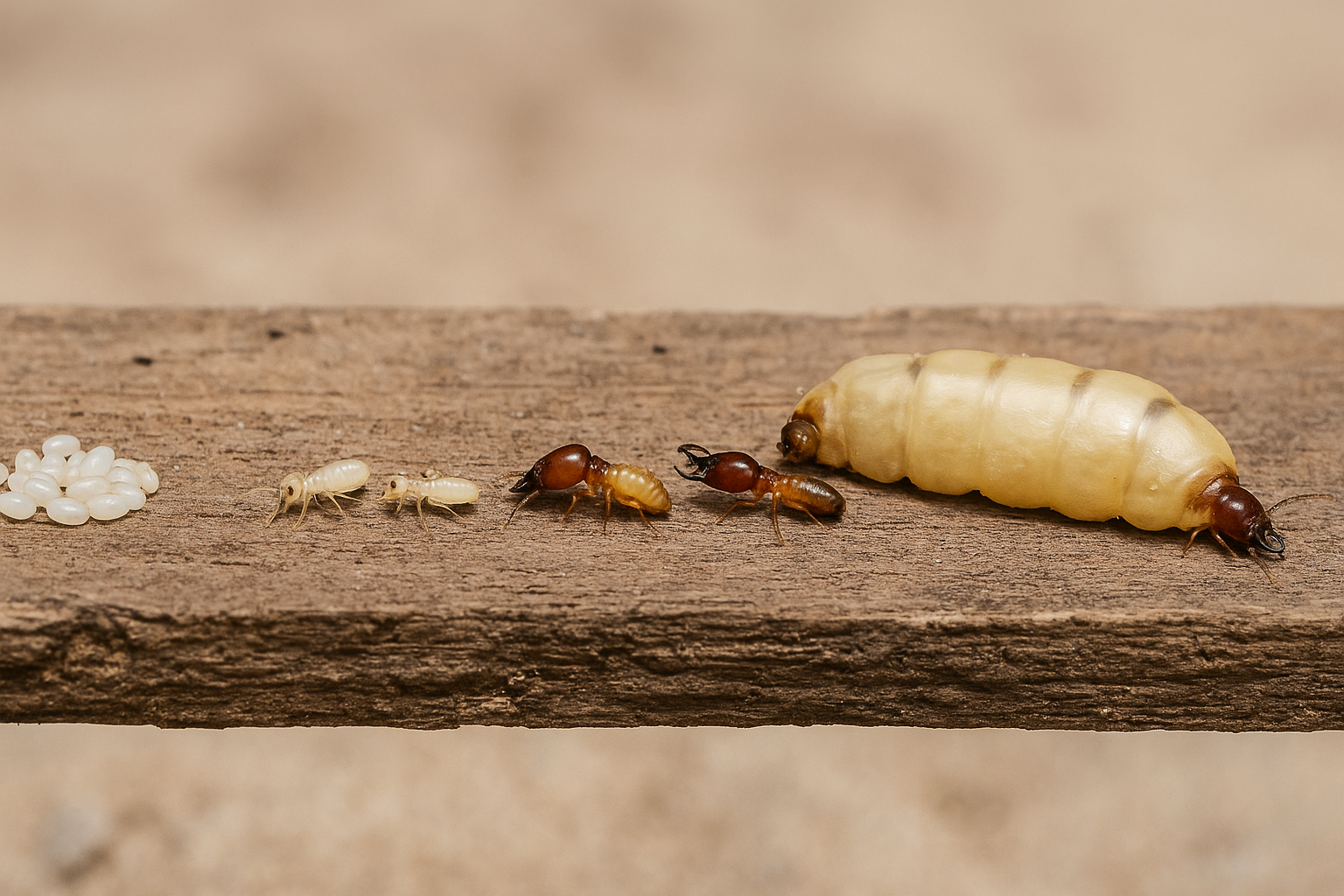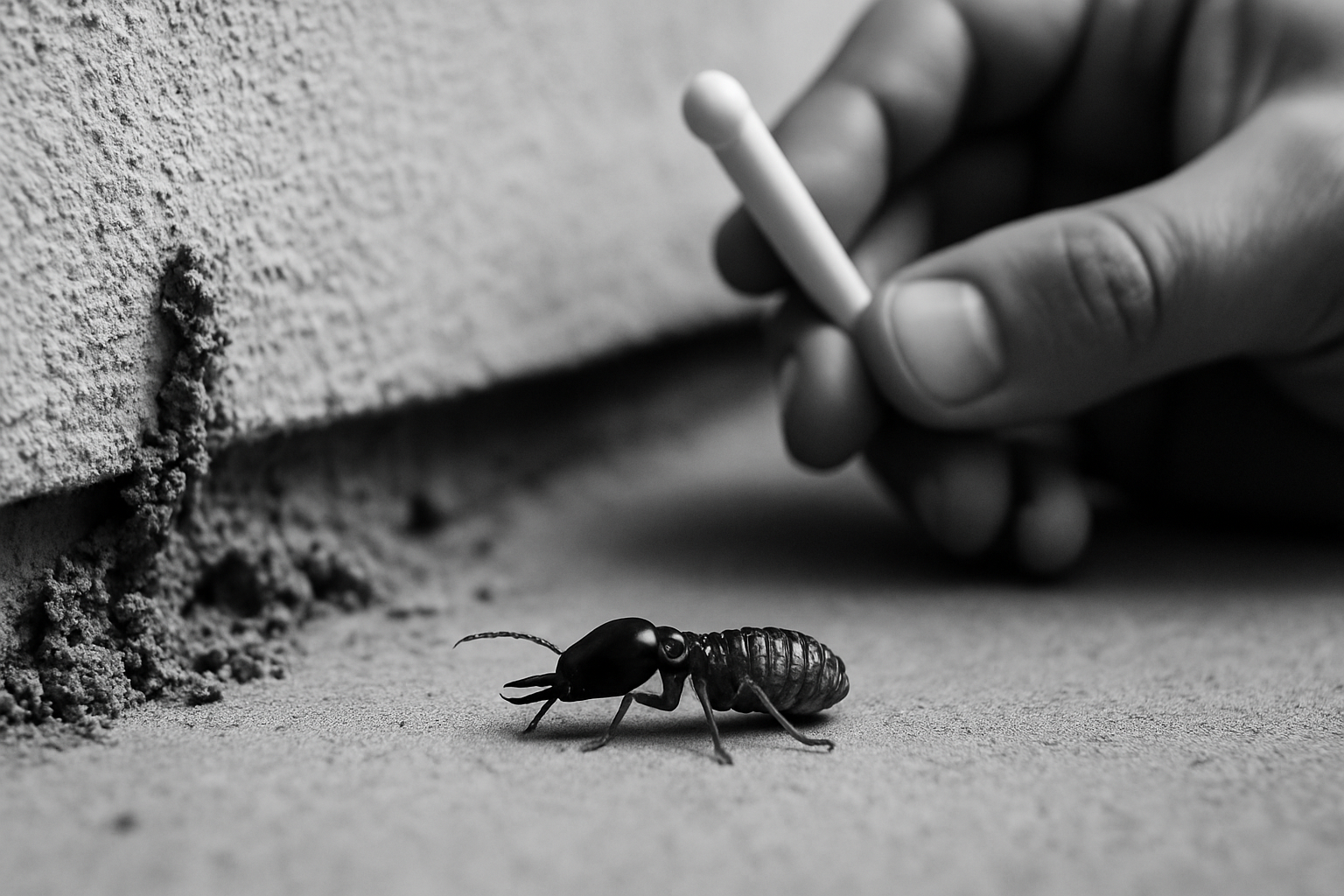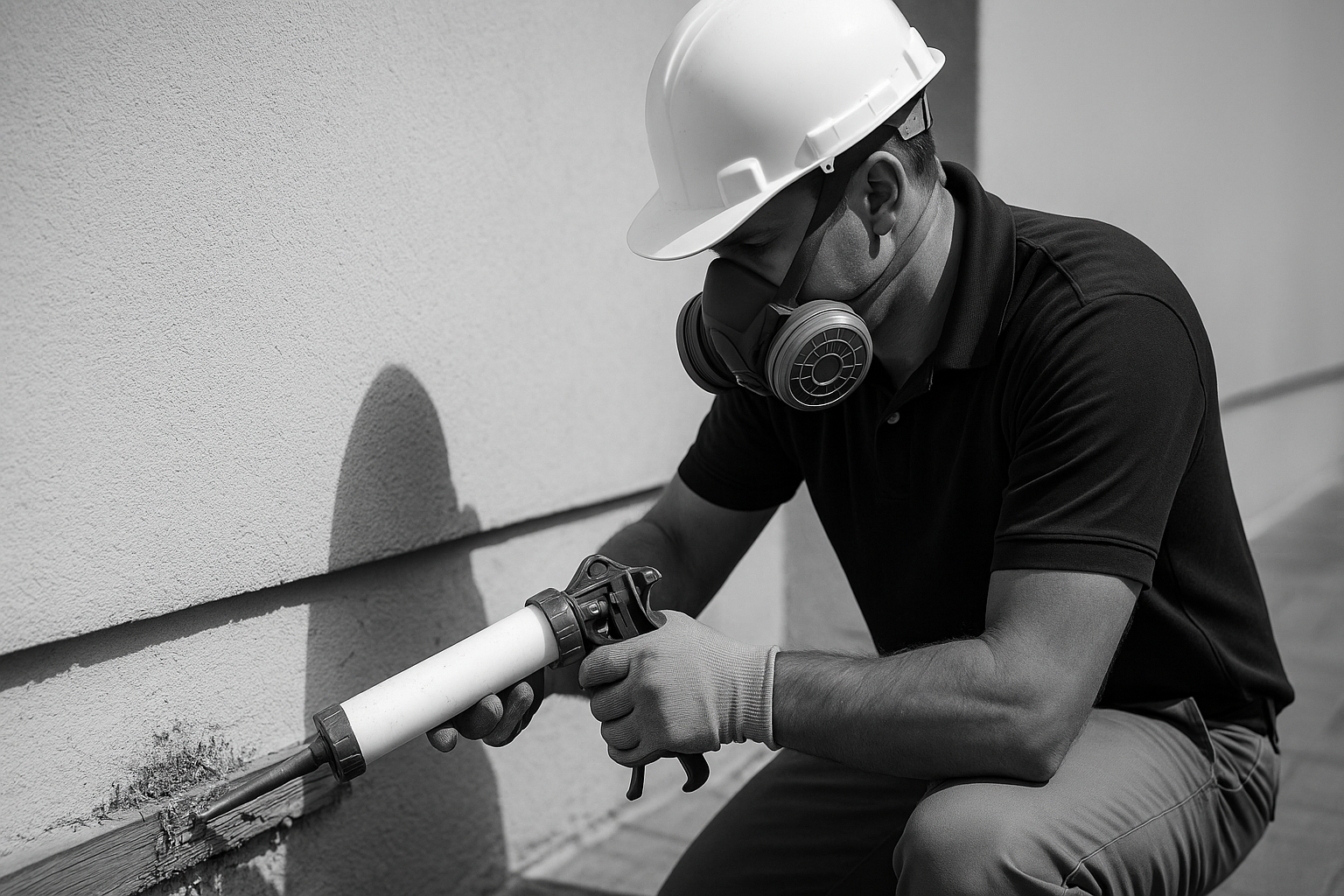Table of Contents
Understanding Termite Life Cycle Al Khawaneej 1
The termite life cycle al khawaneej 1 is a pivotal concept for homeowners and businesses in Dubai to grasp in order to effectively manage termite infestations. Termites, particularly common in the desert-climate regions like Al Khawaneej 1, undergo a complex life cycle that fuels their colony growth and the consequent risks they pose to structures. Understanding the nuances of the termite life cycle al khawaneej 1 ensures proactive pest control measures can be taken.
Termites pass through distinct stages: egg, nymph, and adult, each with specific roles within the colony such as workers, soldiers, and reproductive termites (alates). Understanding these phases enables more precise timing for intervention and control. Timely intervention depends on a comprehensive knowledge of the termite life cycle al khawaneej 1.
In Al Khawaneej 1, termites especially favor wooden and cellulose-based materials prevalent in residential and commercial buildings, which underscores the importance of early detection based on their life cycle dynamics. Effective management of the termite life cycle al khawaneej 1 is key to preserving property value.
Detailed Termite Inspection Services in Al Khawaneej 1
A professional termite inspection in Al Khawaneej 1 is essential for identifying termite presence before irreversible damage occurs. Experts specializing in the termite life cycle al khawaneej 1 focus on multiple factors including visible swarmers, mud tubes, and damaged wood patterns consistent with termite activity. These specialists leverage their deep understanding of the termite life cycle al khawaneej 1 to pinpoint hidden threats.
These inspections follow a systematic approach:
- Visual Examination: Scouting all potential entry points and infestation evidence around structures.
- Moisture Assessment: Since termites thrive in damp areas, the evaluation of plumbing leaks and humidity levels is crucial.
- Use of Specialized Equipment: Including moisture meters and infrared cameras to detect hidden termite activity.
Dubai residents can also rely on licensed pest control services listed on Dubai Municipality’s official portal for verified and safe termite control solutions. For in-house services, Saniservice Dubai offers specialized services for the termite life cycle al khawaneej 1, providing comprehensive inspections and treatment tailored for homes and businesses in Al Khawaneej 1.
Common Questions about Termite Infestations Al Khawaneej 1
Understanding community concerns about termites in Al Khawaneej 1 enhances protection quality. Here are frequently asked questions with actionable answers:
Q1: How quickly do termites reproduce in Al Khawaneej 1?
The termite life cycle al khawaneej 1 allows rapid colony expansion, especially during Dubai’s warmer months. Reproductive termites can swarm and establish new colonies within weeks, making timely detection critical. Understanding the pace of the termite life cycle al khawaneej 1 helps in planning immediate action.
Q2: What signs indicate early termite infestation?
- Small piles of discarded wings near windowsills and doors.
- Hollow-sounding wood when tapped.
- Presence of mud tubes along walls or foundations.
Q3: Are termite treatments safe for families and pets?
Yes, licensed professionals in Dubai use approved, environmentally friendly solutions that comply with Dubai Health and Safety regulations, ensuring safety during and after treatment.
Q4: How often should termite inspections occur in Al Khawaneej 1?
It is advisable to schedule termite inspections annually, especially for properties constructed with wood components or those situated near vegetated areas.
Effective Prevention and Control Strategies
Mastering the termite life cycle al khawaneej 1 informs the most effective prevention and mitigation efforts. The following strategies are highly recommended for residential and commercial properties: A thorough grasp of the termite life cycle al khawaneej 1 is paramount for developing robust defense mechanisms.
- Regular Inspections: Early detection through professional inspections disrupts termite reproduction before severe damage.
- Moisture Control: Fix plumbing leaks and improve drainage to minimize conducive termite habitats.
- Wood Treatment: Applying borate-based preservatives on wood during construction or renovations inhibits termite feeding.
- Physical Barriers: Using termite shields and sand barriers compliant with Dubai Municipality pest control standards.
- Prompt Repairs: Repair damaged wood and plaster immediately.
Employing an integrated pest management approach tailored to Dubai’s climate and urban conditions delivers the best long-term results. Local experts equipped with knowledge of the termite life cycle al khawaneej 1 can customize interventions for Al Khawaneej 1 environments.
Regulations and Health Considerations in Dubai
In Dubai, termite control and inspection are governed by Dubai Municipality’s Public Health and Pest Control Section, ensuring that pest management follows strict safety and environmental guidelines. For authoritative resources, visit the Dubai Municipality Pest Control Section.
Health-wise, while termites do not transmit diseases, their presence can cause structural hazards risking injury. Proper termite management also limits secondary infestations from other pests attracted to compromised wood structures.
Compliance with city regulations and utilizing certified pest control providers improve safety and efficacy, reducing the negative impact of termite infestations on Al Khawaneej 1 properties.
Conclusion and Next Steps
An in-depth understanding of the termite life cycle al khawaneej 1 is essential for effective prevention, early detection, and control. By partnering with professional inspection services and adhering to local regulations, residents of Al Khawaneej 1 can safeguard their homes and commercial properties from costly termite damage. This comprehensive insight into the termite life cycle al khawaneej 1 empowers residents and businesses to maintain structural integrity.
Take action today: schedule a comprehensive termite inspection and learn more about managing the termite life cycle al khawaneej 1 and tailored pest management options that suit your specific needs within Dubai’s unique environment.
Understanding the Detailed Termite Life Cycle in Al Khawaneej 1
The termite life cycle is a fascinating yet complex process that plays a crucial role in the development and spread of termite colonies, particularly in Dubai neighborhoods like Al Khawaneej 1. Recognizing each stage of this cycle can empower homeowners and property managers to better anticipate potential infestations and engage in effective termite control strategies tailored for the unique environmental conditions of the area.
Stages of the Termite Life Cycle
The termite life cycle in Al Khawaneej 1 follows the same fundamental biological progression as termites worldwide but is influenced by the subtropical desert climate of Dubai. This climate affects termite behavior, reproduction rate, and colony growth. The stages include:
- Egg Stage: Female termites lay hundreds of tiny, white eggs within protected nests or wooden structures that provide moisture and shelter.
- Larval Stage: The eggs hatch into larvae, which undergo successive molts as they develop. These immature termites depend entirely on worker termites for nourishment.
- Worker Stage: Workers are sterile and perform the essential tasks of foraging, nest maintenance, and feeding other colony members.
- Soldier Stage: Soldiers develop specialized mandibles to defend the colony from predators like ants.
- Reproductive Stage: Also known as alates or swarmers, these winged termites are responsible for starting new colonies. They leave the nest to mate and establish new nests in suitable locations, often following seasonal patterns noted in Dubai’s climate.
- King and Queen Stage: The reproductive pair establishes the new colony, with the queen capable of laying thousands of eggs throughout her lifetime.
Each stage is interdependent, maintaining the colony’s survival and expansion. In Al Khawaneej 1, the relatively higher humidity levels compared to central Dubai create an inviting environment for termite activity, especially in older buildings with wooden elements or poorly ventilated crawl spaces.
Environmental Factors Influencing the Cycle in Al Khawaneej 1
The termite life cycle in Al Khawaneej 1 is not only biological but also environmentally driven. Several local factors influence how quickly a colony develops and spreads:
- Temperature & Humidity: Dubai’s climate, especially in Al Khawaneej 1, features warm temperatures with sudden humidity spikes during certain months. These conditions accelerate termite breeding and larval development.
- Human Activity: Construction practices, landscaping, and water irrigation in residential areas can inadvertently create moisture pockets, inviting termite nests to flourish.
- Building Materials: Use of untreated wood or porous materials in interiors and exteriors provides abundant food sources for termites, extending their life cycle efficiently.
Because of these factors, the termite reproduction and growth phases can be more rapid here than in drier regions of Dubai, compelling residents to remain vigilant year-round.
Termite Colony Expansion and Its Impact in Al Khawaneej 1
Understanding the termite life cycle al khawaneej 1 means recognizing the critical point at which colonies become visible and problematic. Early in the colony’s establishment, termites reside hidden within wooden structural components or underground tunnels. Without detection, they grow their populations exponentially through continuous egg-laying by the queen, sustained by worker termites feeding exclusively on cellulose materials.
When colonies mature, they produce swarmers that leave the nest to reproduce and create satellite colonies. These swarm events often occur during the spring and early summer months in Dubai, especially after rare rainfalls or localized increases in humidity. For homes in Al Khawaneej 1, a sudden appearance of flying termites inside or around buildings is a clear sign that multiple colonies may be nearby or within the property itself.
Unchecked, the continuous termite life cycle can lead to significant structural damage over time, weakening wooden beams, furniture, and even compromising foundations when subterranean termites tunnel extensively.
How Lifecycle Knowledge Helps in Effective Termite Management
By understanding the termite life cycle al khawaneej 1, pest management professionals and homeowners can better time and tailor treatments to interrupt specific stages. For instance:
- Targeting Swarmers: Detecting and intercepting alates during swarming season provides a critical window to prevent new colony formations.
- Focused Larval Control: Treatments aimed at larvae and workers reduce the colony’s ability to sustain itself, effectively shrinking the population.
- Queen Elimination: Although challenging, terminating the queen disrupts egg-laying, leading to colony collapse.
Pest control companies in Dubai, such as Saniservice, integrate lifecycle knowledge with Dubai Municipality’s environmental and safety regulations to provide sustainable termite control solutions specifically for neighborhoods like Al Khawaneej 1. Regular inspections are recommended to detect termite presence before colony expansion becomes unmanageable, as per guidelines from the Dubai Health Authority (DHA) and Dubai Municipality pest control standards.
In summary, the termite life cycle al khawaneej 1 presents unique challenges and opportunities for effective management. Understanding each stage within the local climatic context is essential for protecting residential and commercial properties in Dubai’s Al Khawaneej 1 area from these resilient pests.





